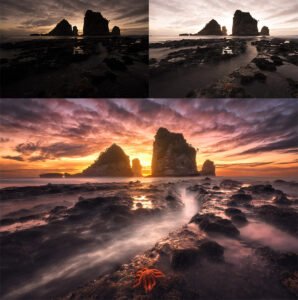Photography has always been a delicate balance between art and science. At its core, photography is about capturing light in creative and meaningful ways. Among the most intriguing techniques in modern photography is multiple exposure blending. This method allows photographers to merge two or more images into a single composition, resulting in surreal, dreamy, or highly conceptual visuals that stand out. While the concept may seem straightforward, understanding the science behind it can transform your results from ordinary to extraordinary.
Understanding Light and Exposure
To fully appreciate multiple exposure blending, one must first understand light and exposure. Exposure is determined by three key elements: aperture, shutter speed, and ISO. The aperture controls how much light enters the camera, the shutter speed determines the duration of light exposure, and ISO adjusts the camera sensor’s sensitivity to light. By mastering these elements, photographers can capture images that are optimally lit, providing a strong foundation for blending multiple exposures.
Light quality also plays a critical role. Hard light, soft light, and directional lighting each produce unique effects in a photo. Hard light creates strong shadows and sharp contrasts, while soft light offers gentle transitions and a more ethereal feel. Directional light can guide the viewer’s eye and enhance textures. When combining images for multiple exposure blending, understanding how these light types interact can help you achieve a harmonious final composition.
Multiple Exposure Blending: A Fusion of Art and Science
Multiple exposure blending is the process of merging different photographs into one cohesive image. This technique can be achieved either in-camera, by exposing the same frame multiple times, or digitally through software like Photoshop. The goal is to create a composition that appears seamless, yet often carries abstract or layered storytelling elements.
From a scientific standpoint, multiple exposure blending relies on the principles of light and pixel data. Each image contains specific light information that, when combined, creates the final exposure. By carefully adjusting opacity, blending modes, and masks in digital editing, photographers can control which parts of each image are visible, how they interact, and the overall tonal balance. Understanding histograms and exposure values is crucial for ensuring that no detail is lost during the blending process.
Techniques for Effective Multiple Exposure Blending
Achieving a compelling multiple exposure blend involves both technical skill and artistic intuition. One popular approach is the “light painting” method, where a long exposure captures moving light sources in combination with a static subject. Another method involves blending a silhouette with a textured background or urban scene, creating striking contrasts and visual depth.
Layer masks are essential in digital multiple exposure blending. They allow selective control over each layer, letting you reveal or hide portions of an image without permanently altering the original photograph. Blending modes such as Screen, Overlay, or Multiply manipulate how light interacts between layers, giving photographers creative control over the final appearance.
It’s also important to consider color theory. Colors can either harmonize or clash depending on the mood you want to create. Adjusting hues, saturation, and brightness across layers ensures the final image has a coherent visual language that resonates with viewers.
Practical Tips for Mastering Multiple Exposure Blending
Experimentation is key to mastering multiple exposure blending. Start by planning your shots with a clear vision of how the images will combine. Lighting consistency is critical; mismatched light sources can make the blend appear unnatural. Keep a record of exposure settings for each shot, making it easier to recreate successful combinations.
Post-processing skills are equally important. Software tools like Adobe Photoshop or Lightroom provide advanced features for aligning images, correcting exposure discrepancies, and fine-tuning color balance. Don’t hesitate to experiment with unusual combinations; some of the most compelling blends arise from unexpected juxtapositions.
Finally, patience and practice cannot be overstated. Multiple exposure blending is both a technical challenge and an artistic endeavor. The more you experiment with light, exposure, and layering techniques, the more intuitive the process becomes, allowing your creativity to flourish.
Conclusion
The science behind multiple exposure blending and light manipulation combines technical knowledge with artistic vision. By understanding how light, exposure, and color interact, photographers can create images that are not only visually captivating but also emotionally resonant. Whether executed in-camera or through digital software, multiple exposure blending opens a world of possibilities for telling stories through layered imagery. With practice, attention to detail, and a curiosity for experimentation, you can elevate your photography and produce images that push the boundaries of creativity.




